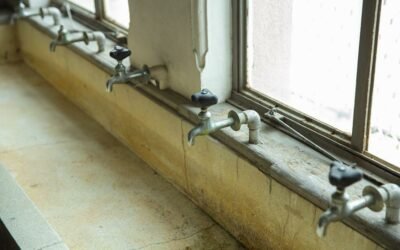Do you ever wonder why flies seem to swarm around moldy areas in your home?
In this article, we will explore the fascinating relationship between mold and flies.
Discover the factors that attract flies to mold, how mold spores entice these pesky insects, and the risks associated with mold and fly infestations.
Furthermore, we will provide you with valuable tips to prevent the growth of mold and the subsequent infestation of flies in your living space.
Key Takeaways
- Mold attracts flies because it provides a source of food for them.
- Flies are primarily attracted to mold because of the odors it emits.
- Mold spores entice flies with their airborne presence and enticing scent.
- Mold can cause significant damage to property and pose health risks, while fly infestations can spread disease-causing pathogens.
The Relationship Between Mold and Flies
When it comes to the relationship between mold and flies, you might be wondering if mold actually attracts flies. The answer is yes, mold does attract flies.
Flies are attracted to mold because it provides them with a source of food. Mold grows on organic materials such as food, plants, and damp surfaces, and it releases a strong odor that's attractive to flies.
Flies are attracted to the smell of decomposing organic matter, which is exactly what mold is. Mold breaks down organic material by releasing enzymes and digesting it. As mold grows and spreads, it produces volatile organic compounds (VOCs), which are responsible for the characteristic musty odor. Flies have a highly developed sense of smell, and they're able to detect these odors from a distance.
Once flies are attracted to the mold, they'll land on the surface and feed on it. Flies have specialized mouthparts that allow them to suck up liquid and semi-liquid substances. They'll consume the mold spores, mycelium, and any other organic matter present in the mold. In the process, they also help in the dispersal of mold spores, aiding in the mold's reproduction.
Factors That Attract Flies to Mold
To attract flies to mold, there are several factors that come into play.
Flies are attracted to mold primarily because of the odors it emits. Mold produces volatile organic compounds (VOCs) that have a strong and distinct smell, which acts as a signal for flies. These VOCs are released as mold feeds on organic matter, such as decaying food or plant materials. The odors act as a chemical attractant, drawing flies towards the mold-infested area.
In addition to the odors, flies are also attracted to the moist environment that mold provides. Mold thrives in damp conditions, and the presence of moisture creates an ideal breeding ground for flies. Flies are attracted to areas with high humidity levels, as it enhances their survival and reproduction.
Furthermore, the presence of mold often indicates the presence of decaying organic matter, which serves as a food source for flies. Flies are opportunistic feeders and are attracted to rotting materials. Mold-infested areas usually have a ready supply of decaying matter, making them attractive feeding grounds for flies.
It is important to note that not all species of flies are attracted to mold. Certain species, such as fruit flies and house flies, have a strong affinity towards mold due to their feeding habits. However, other species may not be as attracted to mold and may be more drawn to different sources of food and breeding sites.
How Mold Spores Entice Flies
Mold spores entice flies with their airborne presence and enticing scent. Flies are attracted to the odorous compounds released by mold as they search for food sources. The table below provides a breakdown of the specific factors that make mold spores so enticing to flies.
| Factors that Entice Flies | Explanation |
|---|---|
| Odor | Mold releases volatile organic compounds (VOCs) that produce a distinctive smell, which attracts flies from a distance. The scent serves as a signal for potential food sources. |
| Moisture | Mold requires a moist environment to grow and reproduce. The presence of moisture not only promotes mold growth but also creates an ideal breeding ground for flies. Flies are drawn to the dampness as it signifies a suitable habitat for them to lay their eggs. |
| Decomposing Matter | Mold colonies often develop on organic materials that are decomposing, such as food waste, rotten fruit, or decaying plants. These materials provide nourishment for both mold and flies, making the area doubly appealing to these insects. |
| Warmth | Mold thrives in warm temperatures, and flies are more active and attracted to warmer environments. The combination of mold growth and a warm setting creates a hospitable space that flies find irresistible. |
Understanding the factors that attract flies to mold can help in implementing effective prevention and control measures. By addressing these conditions, such as reducing moisture and removing decomposing matter, you can discourage both mold growth and fly infestations.
Risks Associated With Mold and Fly Infestations
Be aware of the risks that come with mold and fly infestations in order to protect your home and health.
Mold and fly infestations pose several risks that can have negative impacts on both your living space and your well-being.
First and foremost, mold can cause significant damage to your property. It has the potential to weaken structures, stain surfaces, and deteriorate materials such as wood, drywall, and insulation. Additionally, mold can release spores into the air, which can cause respiratory issues, allergies, and asthma attacks, especially in individuals with pre-existing respiratory conditions.
Furthermore, fly infestations can lead to a range of problems. Flies are known to carry disease-causing pathogens such as bacteria, viruses, and parasites. These pathogens can contaminate food surfaces, utensils, and even the food itself, increasing the risk of foodborne illnesses. Furthermore, fly droppings and regurgitated material can further contribute to the spread of bacteria and other harmful microorganisms. In addition to health concerns, fly infestations can be a nuisance, causing annoyance, discomfort, and a negative impact on the overall hygiene of your home.
To avoid these risks, it's important to address mold and fly infestations promptly. Implementing proper cleaning and maintenance practices, such as keeping your living space dry and well-ventilated, promptly fixing any water leaks or moisture issues, and regularly cleaning and disinfecting surfaces can help prevent mold growth and fly infestations. Additionally, using fly traps, screens, and practicing good food hygiene can help deter flies and reduce the risk of contamination.
Preventing Mold Growth and Fly Infestations
To prevent mold growth and fly infestations, you should maintain proper cleaning and maintenance practices in your home. Here are some important steps you can take to keep your living space free from both mold and flies:
- Keep your home dry: Moisture is a breeding ground for mold and flies. Regularly check for and fix any leaks in pipes, roofs, or windows. Use dehumidifiers in areas prone to excessive moisture, such as basements or bathrooms.
- Clean up spills promptly: Any spilled liquids, especially food or sugary substances, should be cleaned up immediately. These can attract flies and provide a food source for mold growth.
- Regularly clean and declutter: Dust, dirt, and clutter can create an ideal environment for both mold and flies. Regularly vacuum, dust, and mop your home to remove any potential food sources or hiding places for pests.
- Properly store food: Keep all perishable foods tightly sealed in containers or in the refrigerator. Avoid leaving food out for extended periods, as this can attract flies and encourage mold growth.
- Dispose of trash properly: Make sure to dispose of trash regularly and keep trash cans clean and sealed. Flies are attracted to rotting food and organic waste, so proper waste management is crucial.
Conclusion
In conclusion, mold does attract flies due to factors such as the release of volatile organic compounds and the presence of decaying organic matter.
Mold spores entice flies by providing them with a food source and a suitable environment for breeding.
However, it's important to note that mold and fly infestations pose health risks and should be prevented by maintaining proper cleanliness and moisture control in indoor spaces.






0 Comments